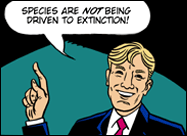My greatest regret about the Lomborg scam is the extraordinary amount of scientific talent that has to be expended to combat it in the media. We will always have contrarians like Lomborg whose sallies are characterized by willful ignorance, selective quotations, disregard for communication with genuine experts, and destructive campaigning to attract the attention of the media rather than scientists. They are the parasite load on scholars who earn success through the slow process of peer review and approval. The question is: How much load should be tolerated before a response is necessary? Lomborg is evidently over the threshold.
Lomborg’s estimate of extinction rates is at odds with the vast majority of respected scholarship on extinction. His estimate, “0.7 percent over the next 50 years” — or 0.014 percent per year — is an order of magnitude smaller than the most conservative species extinction rates by authorities in the field. Here is my brief response to the analysis of extinction rates in The Skeptical Environmentalist.
Before humans existed, the species extinction rate was (very roughly) one species per million species per year (0.0001 percent). Estimates for current species extinction rates range from 100 to 10,000 times that, but most hover close to 1,000 times prehuman levels (0.1 percent per year), with the rate projected to rise, and very likely sharply. To wit:

Based on the work of Stuart Pimm of Columbia University’s Center for Environmental Research and Conservation, anywhere from one to several bird species go extinct annually out of 10,000 known species — hence, say 0.01-0.03 percent of living bird species are extinguished per year. But birds are unusual in that threatened bird species receive an extraordinary amount of human intervention: The real figure of observed extinctions would be much higher, very likely 10 (0.1 percent) per year or more, were it not for heroic efforts to save species on the brink of extinction. Captive breeding, strict protection, and maintenance of reserves especially designed for bird and mammal species have many species hanging on that would otherwise have gone globally extinct in the past several decades. See, for example, the special treatment accorded the nine critically endangered but extant psittacids (parrots). If you look at non-bird species — for example, terrestrial and freshwater mollusks, a relatively unprotected group — the extinction rates are much higher.
The above consideration confirms the likely current extinction rate of 0.1 percent, 1,000 times greater than prehuman levels. That figure is also supported by the following indirect measures:
- Area-species curves. Ecological research across a wide range of habitats shows that the number of species inhabiting a patch of land increases exponentially with the size of that patch. Different studies have produced different estimates for the species-area exponent; the higher the value of the exponent, the steeper the general relationship between land area and species diversity, so that a small change in land area has a large effect on diversity. In The Diversity of Life, I use the conservative values of the area-species exponent and rate of tropical deforestation to arrive at about 0.25 percent of tropical forest species extinguished or committed to early extinction annually. Since most species likely occur in tropical forests, these ecosystems are a good proxy: Even if no extinction occurred elsewhere, the planetary rate would still be 0.1 percent annually.
What do we mean by “committed to early extinction?” Studies from tropical America, New Guinea, and Indonesia (cited in The Diversity of Life) show that when forest fragments are reduced to anywhere from one to 27 square kilometers, 10 to 50 percent of the species in the fragment go extinct within 100 years, consistent with the Diamond-Terborgh models of exponential decay. The area-dependent decline in mammal species of the U.S. and Canadian western national parks also accords with the picture of committed extinction by area reduction alone.
- The velocity of passage of species through the categories in the World Conservation Union (IUCN) Red List of Threatened Species, from less endangered to extinct. This movement is also consistent with an extinction rate of 0.1 percent annually, at least for the best-known animal groups.
- Population Viability Analyses. These studies assess the risk of extinction for individual small populations. Although not enough species have been studied this way to produce regional or global extinction rate estimates, the high risk evident in the populations that have been examined is consistent with a high ongoing extinction rate.

At current levels of habitat destruction, extinction rates are destined to rise, and — I believe every researcher would agree — dramatically so. Consider that at an area-species exponent of 0.27 (a typical middle level), half the species are extinguished or committed to extinction by a 90 percent reduction in habitat area. But only another 10 percent reduction (to zero habitat) eliminates the rest of the species locally, and globally for species endemic to the patch.
Now consider that some 35 percent of Earth’s land vertebrates and 44 percent of its plant species are limited to 1.4 percent of its land surface, the 25 widely recognized “hotspots,” which contain about the land mass of Alaska and Texas put together. Consider, too, that the forests and other habitats in these remaining areas have been reduced to 10 percent of their prehuman levels (see, for example, Norman Myers et al., Nature 403, 2000), and most are at immediate risk of disappearing.
Finally, consider that species extinction is increasingly enhanced by pollution, climate change, and the growing flood of invasive species — hence the foregoing estimates of extinctions based on habitat reduction are, sadly, minimal and modest.

